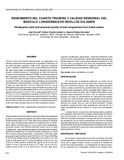Rendimiento del cuarto trasero y calidad sensorial del músculo Longissimus de novillos zulianos
Date
2009-05-12Palabras Clave
Novillos, Palatabilidad, Rendimiento carniceroSteers, Palatability, Cut yield
Metadata
Show full item recordAbstract
Veinte novillos de historia desconocida, se segregaron por fenotipo aparente en los corrales de un matadero comercial, en
tres tipos raciales: mestizos Cebú (n=5), mestizos Lecheros (n=9) y mestizos Indefinidos (n=6); para determinar el efecto
del tipo racial sobre el rendimiento al desposte del cuarto trasero, calidad sensorial y resistencia al corte del músculo
longissimus por Warner-Bratzler (FCWB). El análisis de varianza por cuadrados mínimos no detectó diferencias significativas
(P>0,05) entre tipos raciales para los atributos sensoriales de la carne y FCWB. Los animales Cebú aventajaron a los animales
de predominio racial indefinido y lechero, respectivamente, en el peso en canal (253,6 vs. 221,0 y 229,9 kg; P<0,01) y en el
rendimiento de cortes traseros como el solomo de cuerito (4,52 vs. 3,56 y 3,64%; P<0,05), lomito (2,76 vs. 2,41 y 2,34%; P<0,05), ganso (3,78 vs 3,29 y 3,30%; P<0,01), pulpa negra (8,25 vs 7,17 y 7,41%; P<0,01) y muchacho cuadrado (4,26 vs 3,67 y 3,91%; P<0,05). Dentro de las limitaciones de este estudio, los animales de mayor predominio cebuíno pueden rendir mas en cortes de alto valor sin que sus carnes difieran en calidad sensorial a la de otros tipos raciales típicos de doble propósito zuliano.
Información Adicional
| Otros Títulos | Hindquarter yield and sensorial quality of beef Longissimus from Zulian steers |
| ISSN | 0798-2259 |
| Resumen en otro Idioma | Twenty steers of unknown history were phenotypically segregated at pens of a commercial abattoir into three breed-type groups: Predominantly Zebú (n=5), Dairy-Zebu dual-purpose Crossbred (n=9), and Undefined dual-purpose Crossbred (n=6); to determine effects of breed type on cut-out yield of the hindquarter, sensorial quality and Warner-Bratzler shear force of beef longissimus. Least squares analyses of variance did not show significant differences in sensorial quality attributes or shear force values among breed types. Carcasses of the Zebu-type group were significantly heavier (253.60 vs 221.00 and 229.9kg; P<0.05) and yielded more of hindquarter cuts such as: rib-loin (4.25 vs 3.56 and 3.64%; P<0.05), tenderloin (2.76 vs 2.41 and 2.34%; P<0.05), gluteus (sirloin butt) group (3.78 vs 3.29 and 3.30%; P<0.01), top round (8.25 vs 7.17 and 7.41%; P<0.01), bottom round (4.26 vs 3.67 and 3.91%; P<0.05), than dualpurpose counterparts, respectively. Under the limitations of the study it can be concluded that, steers with a higher phonotypical predominance of Bos indicus demonstrated superiority in the cut-out yield of expensive cuts from the hindquarter without showing significant differences in regard to meat quality when compared to typical dual-purpose cattle types. |
| Colación | 622 - 625 |
| Periodicidad | Bimestral |
| Institución | Universidad del Zulia (LUZ) Universidad de Los Andes (ULA) |
| Publicación Electrónica | Revista Científica |






